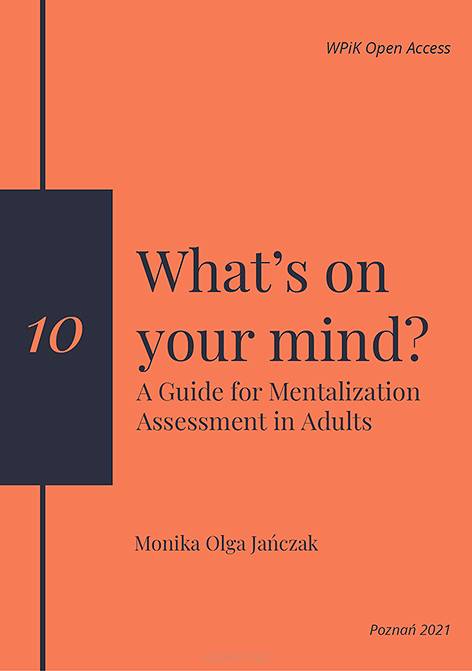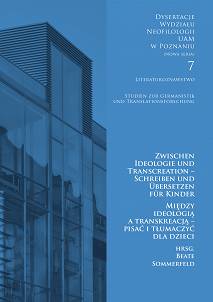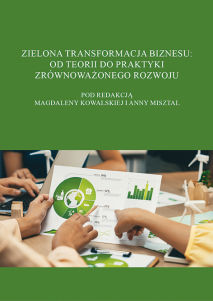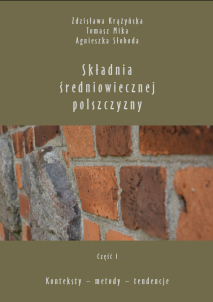Monika Olga Jańczak, What’s on your mind? A Guide for Mentalization Assessment in Adults
- Autor: Jańczak Monika Olga
-
Dostępność:
 Nakład wyczerpany
(0 egz.)
Nakład wyczerpany
(0 egz.)
- egz.
- Cena netto: 0,00 zł 0,00 zł
Wydanie I,
Poznań 2021
Format 21x14,5 cm
ISBN 978-83-66666-85-6
DOI: 10.48226/978-83-66666-85-6
ss. 120
język: angielski
The theory of mentalization, put forward by Fonagy (1996) over twenty years ago, indubitably remains one of the most dynamic concepts to have developed in clinical psychology in recent years. Mentalization is measured in a wide range of contexts, particularly in relation to pathogenesis and pathomechanism of mental disorders (including personality disorders, mood disorders, eating disorders, and developmental disorders)—but also in research into the effectiveness of psychotherapy, especially regarding mentalization-based therapy and psychodynamic therapies for patients with severe personality pathology (Bateman et al., 2019; Diamond et al., 2014; Kernberg et al., 2008). Recently, level of mentalizing proved to be related both to Criterion A and B of the DSM 5 Alternative Model of Personality Disorders (Ball Cooper et al., 2021; Rishede et al., 2021; Zettl et al., 2020). Furthermore, therapists’ mentalizing abilities seem to have a very significant effect on the way in which the psychotherapeutic process unfolds (Shaw et al., 2019). Mentalization is also studied in the developmental context, with the aim to determine the relationships between the level of parental mentalization and various indicators of the child’s functioning (Anis et al., 2020; Law et al., 2021). Likewise, the area of mentalizing in healthy individuals is attracting growing attention lately (Colle et al., 2020; Schwarzer et al., 2021). Undoubtedly, the assessment of this important and commonly used construct elicits the interest of researchers universally.feelings, desires, beliefs, and intentions. More specifically, the capacity of parents to keep their child’s mental states in mind is referred to as parental RF. RF has been linked to adult mental health and parental RF to children’s mental health and development. The gold standard measure of RF is the interview-based Reflective Functioning Scale (RFS
Since I have been personally involved in investigating the level of mentalization in a research context for over ten years, I have always been interested in examining the concomitant controversies and dilemmas. This book is a natural continuance of a 2016 chapter I wrote that was titled: “Methods of Measuring Mentalization” (Marszał, 2016). Little testifies as much to the increasing popularity of mentalization research as the sea change that has occurred in research measures over the past few years. There were very few instruments as recently as five years ago, and it was not entirely clear what is that they actually measured: their accuracy and reliability had not been established. Back then, we researchers were happy to do the best we could with what we had. Access to measures was a particular challenge, especially in validated versions other than English.
However, currently, the situation is completely different. With many more measures, we now find ourselves confronted with a completely different challenge: how can we choose the best ones, and what criterion should we use? Is the best measure the one that has been discussed in the literature for a long time and is considered the gold standard for measuring mentalizing? Or perhaps we want the one with the best psychometric properties, or one that can be administered rapidly? Or perhaps it is important for us to have a measure in a validated Polish or another language version? Perhaps it should measure mentalization most accurately in several dimensions? Needless to say, there is no one right answer to all these questions. The solution to this dilemma is a thorough analysis of the available measures with a view to helping researchers select the one that best meets the criteria they consider important. This book is designed to help you make that decision. I would like to explore and explicate the most pertinent issues concerning mentalization assessment and to systematically review the available measures. It is my earnest hope that researchers considering a mentalization measure will find here a fairly comprehensive list of tools, with a short but concise commentary, an overview of the research on each, and practical guidelines on its use.
(With the Introduction)
Publikacja dostępna online w formacie pdf w poniższej zakładce: Załączniki
Załączniki
| Zobacz | Opis | Pobierz |
|---|---|---|
 monika-olga-janczak-what-s-on-your-mind-a-guide-for-mentalization-assessment-in-adults-edycja-online.pdf (1.3 MB) monika-olga-janczak-what-s-on-your-mind-a-guide-for-mentalization-assessment-in-adults-edycja-online.pdf (1.3 MB) |
||
 spis-tresci.pdf (229.2 KB) spis-tresci.pdf (229.2 KB) |






